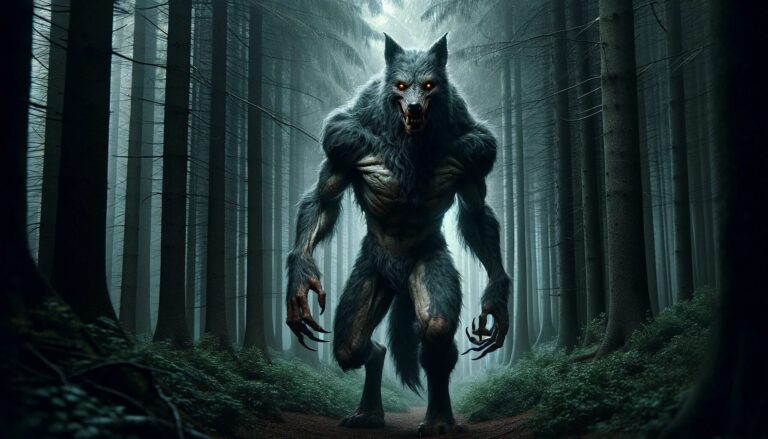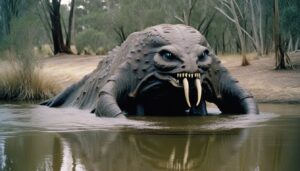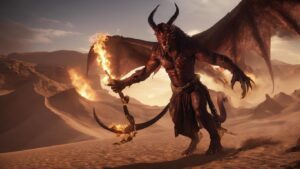Table of Contents
In the moonlit forests of French folklore, a creature of terror and fascination prowls beneath the canopy of ancient oaks and elms. The loup garou, a mythical being known for its shape-shifting abilities, has haunted the imaginations of people for centuries. From the misty hamlets of medieval France to the bustling streets of modern Paris, the legend of the loup garou has endured, weaving a tapestry of myth, fear, and fascination. In this comprehensive exploration, we delve deep into the heart of loup garou lore, unraveling its origins, appearance, abilities, family ties, symbols, and the rich tapestry of myths and stories that have enshrouded this enigmatic creature.
Origins of the Loup Garou
The term “loup garou” is French for “werewolf,” but its origins and evolution in French folklore are steeped in mystery and ambiguity. The concept of the loup garou can be traced back to ancient times when beliefs in shape-shifting creatures existed across various cultures. In France, the loup garou emerged as a distinct figure during the medieval period, blending elements of indigenous folklore with influences from Roman and Germanic traditions.
One possible origin of the loup garou lies in the French countryside, where rural communities relied heavily on agriculture and livestock. Threats to their livelihood, such as wolves and disease, often manifested as fearsome supernatural entities in folklore. These fears may have contributed to the development of the loup garou myth as a way to explain the unexplained and provide a framework for dealing with the unknown.
Appearance
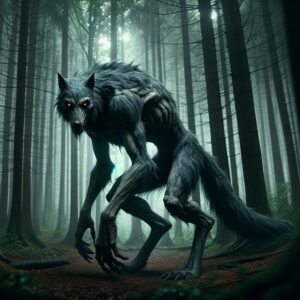
Size and Stature: The loup-garou is often described as a massive and imposing creature, towering over a typical human. It can stand anywhere from 7 to 10 feet tall, making it a truly intimidating presence.
Body: Its body is muscular and powerful, with elongated limbs that allow it to move swiftly and silently through the forests of France. Some depictions show the loup-garou as having a hunched or stooped posture, giving it a more bestial and menacing appearance.
Head and Facial Features: The creature’s head is wolf-like, with a long, narrow snout filled with rows of sharp, serrated teeth. Its eyes, often described as red or yellow, are considered the most terrifying feature, glowing with an eerie, supernatural light that can be seen even in the darkest of nights. The loup-garou’s ears, pointed and often perked, grant it excellent hearing, a common attribute of wolves.
Fur and Coloration: If the loup-garou has fur, it varies in color from mottled gray to deep black, providing excellent camouflage in the shadows and dense forests of France. Some accounts suggest that the creature’s fur can bristle when it is agitated or in a heightened state of aggression.
Limbs and Hands: Its arms are long and muscular, ending in powerful, clawed hands that can easily tear through flesh and vegetation. In some versions of the legend, the loup-garou possesses opposable thumbs on its clawed hands, allowing it to grasp objects and manipulate its surroundings with a frightening dexterity.
Hybrid Features: In certain interpretations of the loup-garou, it retains some human features, such as a partially human face or the ability to stand on two legs. This hybrid aspect adds an unsettling layer of terror, as it blurs the line between a man and a beast.
Abilities
The loup garou’s most notorious ability is its power to transform from a human into a wolf-like creature, often during the full moon. This transformation is usually involuntary and triggered by the lunar cycle, leaving the afflicted individual powerless to resist their beastly nature. When in their lupine form, people believe that loup garous possess enhanced strength, speed, and agility, rendering them formidable predators.
One of the most feared aspects of the loup garou is its insatiable appetite for human flesh, particularly that of children and the elderly. Legends recount the gruesome tales of loup garous stalking remote villages, preying upon unsuspecting victims under the cover of darkness. Their bloodlust knows no bounds, and the terror they inspire is palpable.
In addition to their shape-shifting abilities, loup garous frequently have associations with curses and hexes. People believe that someone may become a loup garou due to a curse or through the hereditary transmission of the condition. To break the curse, one must perform specific rituals or remedies, which often entail the intervention of a skilled witch or priest.
Family Ties
The concept of family ties among loup garous comprises a complex and often ambiguous aspect of the myth. In some versions of the legend, a familial curse can transform a person into a loup garou, indicating that the condition passes from one generation to the next. In such cases, people perceive the affliction as a dark legacy plaguing a particular bloodline.
Conversely, some tales depict loup garous as solitary creatures. Cursed individuals, they roam the night alone, with their transformation into a beast marking them as outcasts from society. These solitary loup garous often appear as tragic figures, tormented by their condition and the harm they unwittingly inflict upon others.
Symbols
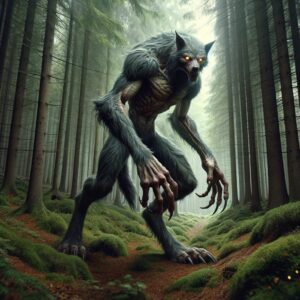
The loup garou associates several symbols with its presence in French folklore. One of the most recognizable symbols is the full moon, which frequently connects to the creature’s transformation. The belief is that the ominous glow of the full moon triggers the change from human to loup garou, infusing the night sky with an element of dread in its appearance.
Another symbol associated with the loup garou is the wolf itself. Wolves have long been symbols of wilderness, cunning, and danger in many cultures. In the context of the loup garou myth, the wolf represents the creature’s predatory nature and its connection to the natural world.
Related Myths and Stories
The loup garou has left its mark on French literature, art, and popular culture, and its presence can be found in a multitude of stories and legends. Here are some notable examples:
The Beast of Gevaudan
In the 18th century, Gevaudan, a remote region in southern France, witnessed a horrifying saga that would become the legendary tale of the Beast of Gevaudan. This enigmatic creature, resembling a formidable and wolf-like beast, unleashed a wave of death and terror, captivating the region in fear and fascination.
The Beast’s reign of terror commenced in 1764 when it brutally mauled and killed a young woman tending to her cattle. Subsequent attacks targeted not only livestock but also a growing number of human victims, often women and children. Eyewitnesses recounted encounters with a monstrous creature, larger than any ordinary wolf, with a sleek, dark coat and fiery, terror-inducing eyes.
The Beast of Gevaudan was audacious, frequently striking in broad daylight, displaying remarkable cunning and agility. It seemed impervious to bullets and conventional hunting methods, deepening the belief that it possessed supernatural powers.
As the attacks persisted, fear and hysteria spread through Gevaudan and its neighboring regions. Local authorities organized numerous hunting parties, including professional hunters, soldiers, and renowned wolf-hunters. However, the elusive Beast continued its deadly spree, leaving behind a mounting death toll.
The legend of the Beast of Gevaudan captured not only the afflicted region’s imagination but also the entire country’s. It became a symbol of primal fear, inspiring tales of bravery and desperation against an unyielding menace. The creature’s true identity remains a topic of debate and speculation, with theories ranging from an exceptionally large and aggressive wolf to a hyena or even a surviving prehistoric predator.
The reign of terror finally ceased in 1767 when a local hunter, Jean Chastel, claimed to have slain the Beast with a silver bullet, believed to be effective against supernatural creatures. While Gevaudan found relief in the Beast’s demise, the legend endured, spawning numerous books, films, and documentaries.
The Red Riding Hood Connection
The classic tale of Little Red Riding Hood portrays a young girl’s journey through the woods to visit her grandmother, carrying a basket of goodies. Along the way, she encounters a cunning wolf who tricks her into revealing her destination, then devours her grandmother before disguising himself as the elderly woman.
The parallels between the wolf in Little Red Riding Hood and the loup garou are striking:
Deceptive Appearance: In both narratives, there is an emphasis on the wolf’s deceptive appearance. The loup garou can appear as a fearsome creature, while the wolf in the story takes on the guise of the girl’s grandmother, adding an element of danger and suspense.
Vulnerable Prey: Little Red Riding Hood represents the archetype of innocent prey, much like the loup garou’s victims. Her naivety and trust make her an ideal target for the cunning wolf, mirroring the loup garou’s attacks on unsuspecting individuals.
Themes of Fear and Caution: Both stories convey lessons about the dangers of the unknown and the importance of caution. Little Red Riding Hood serves as a cautionary tale, warning children to be wary of strangers. The loup garou myth instills fear of the unknown and the wilderness, encouraging people to stay safe indoors at night.
This connection between Little Red Riding Hood and the loup garou underscores the enduring presence of the loup garou in popular culture and its influence on other folklore and literature. Significantly, it demonstrates how folklore and mythology shape narratives, adding layers of meaning and depth that resonate across generations.
Modern Interpretations
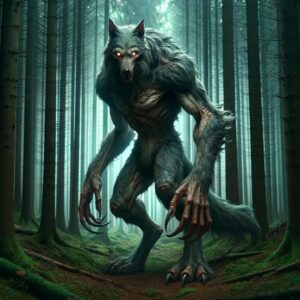
Furthermore, in modern times, the loup garou continues to captivate imaginations. It has appeared in various forms in literature, film, and television, often as a symbol of inner conflict and the struggle between human and animalistic instincts. Contemporary authors and filmmakers have used the loup garou myth to explore themes of identity, transformation, and the blurred boundaries between civilization and the wild.
Cultural Significance
The loup garou remains a significant cultural symbol in France and among French-speaking communities around the world. It serves as a reminder of the power of folklore and myth to shape our perceptions of the natural world and our own inner selves.
In conclusion, the loup garou is a complex and enigmatic creature that has left an indelible mark on French folklore and culture. Its origins are shrouded in mystery, and its appearance is both fearsome and captivating. The loup garou’s abilities, family ties, and associated symbols add depth to its legend, while the rich tapestry of related myths and stories continue to evoke a sense of wonder and terror. Whether seen as a curse or a reflection of humanity’s primal instincts, the loup garou endures as a symbol of the enduring power of myth and the mysteries that lurk in the shadows of the night.
Similarities
The most obvious counterpart is the werewolf in European Folklore. In this mythology, a human is capable of transforming into a wolf or wolf-like creature, often during a full moon. Similar to the loup-garou, werewolves possess supernatural strength and have a tendency for violence.
In Native American Folklore, we encounter the skinwalker. In various Native American cultures, skinwalkers are shapeshifters who can transform into animals, including wolves. They are often associated with dark magic and malevolent intentions.
Transitioning to Hindu Mythology, we find the Rakshasa. These shape-shifting demons are known for their malevolence and have the ability to take on the form of various creatures, including wolves.
Turning our attention to Algonquian Folklore, we discover the wendigo, a supernatural creature associated with cannibalism and an insatiable hunger. Wendigos often manifest as emaciated, monstrous beings with some wolf-like features.
Additionally, in the mythology of various cultures, such as Greek, Egyptian, and Chinese, there is a recurring theme known as cynocephaly. This term refers to mythological creatures characterized by the head of a dog or wolf atop a human body.
In Mesoamerican Folklore, there are naguals. In various Mesoamerican cultures, naguals are shape-shifters who can take the form of animals, including wolves. They are often associated with witchcraft and have both benevolent and malevolent members.
Lastly, in various folklore traditions, there are therianthropes. These beings can transform between human and animal forms. While not specific to wolves, they share a common theme of shape-shifting abilities with the loup-garou.
FAQ
What does "Loup Garou" mean?
"Loup Garou" is French for "werewolf."
Are Loup Garous always evil?
Not necessarily. In some legends, they are depicted as cursed individuals who may not have control over their actions, while in others, they are portrayed as malevolent creatures.
How do you become a Loup Garou?
In some versions of the myth, one becomes a Loup Garou through a curse or through hereditary means, passed down from generation to generation.
Can a Loup Garou be cured?
According to folklore, specific rituals or remedies, often involving the help of a skilled witch or priest, can be used to break the curse and revert a person back to human form.
What powers do Loup Garous have?
Loup Garous are often associated with enhanced strength, speed, and agility, making them formidable predators in their wolf-like form.
Are Loup Garous similar to werewolves?
Yes, Loup Garous are essentially the French counterpart of werewolves in European folklore, both involving humans transforming into wolf-like creatures.
What role do Loup Garous play in modern culture?
Loup Garous continue to appear in literature, film, and television, often symbolizing inner conflict and the struggle between human and animalistic instincts. They are also used to explore themes of identity, transformation, and the clash between civilization and the wild.
